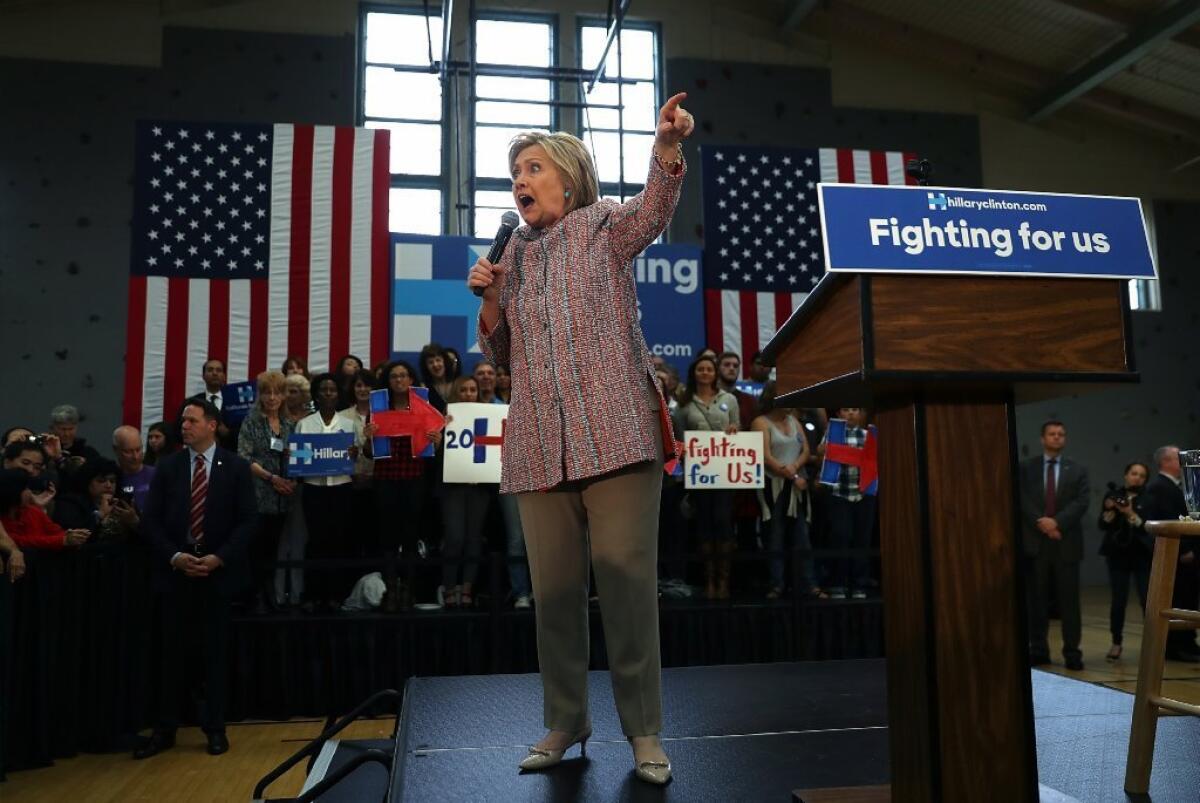In politics, it’s not what you say but how you say it, acoustical analysis shows

- Share via
Even with very different messages, politicians may sound the same, new research finds. Scientists who analyzed the vocal stylings of four presidential contenders in the 2016 race – Hillary Clinton, Carly Fiorina, Bernie Sanders and Donald Trump – found that all four candidates altered their voices in similar ways, depending on the audience.
The findings, described at the Acoustical Society of America meeting in Salt Lake City, offer some insight into the vocal strategies of political speakers.
“Politicians use voice as a very powerful behavior to convey their charisma,” Rosario Signorello, a postdoctoral researcher at UCLA’s Department of Head and Neck Surgery and one of the researchers behind the work, said at a briefing this week.
See the most-read stories in Science this hour >>
When it comes to politics, it’s not what you say, it’s how you say it. There’s a good reason that some of the most successful politicians, for better or worse, are also known as outstanding orators, able to persuade large and diverse crowds with powerful speeches. But it’s not just about the words they choose; the same paragraph on chopped carrots might sound boring in a monotone speaker’s voice but riveting when recited by a Shakespearean actor. Seasoned politicians know this all too well; some presidential hopefuls in this once-crowded election campaign may have learned it the hard way.
Politicians, Signorello said, “are the best public speakers because they face every type of audience, from elementary school to very old people.”
Signorello wanted to see whether there was any way to pin down what makes a politician an effective speaker, by analyzing the strategies they use. So he analyzed the fundamental frequency (the pitch) of the voices of two Democrats and two Republicans: Clinton, Sanders, Trump and Fiorina (who has dropped out of the race).
The researchers looked at three different settings — political rallies, discussions with other political figures, and talk show interviews that did not feature political subject matter. After analyzing three different speeches for each of the three scenarios featuring each candidate, the scientists found that the four politicians shared some similar vocal behaviors – in spite of their differences in party or gender.
When speaking to large crowds, the politicians used a wide pitch range — a strategy that Signorello and his colleagues showed in previous work would help them be seen as charismatic.
“When the candidates addressed [an] audience of perceived and assessed lower status, lower social status, they would use a high vocal pitch range, a high vocal pitch average and a wide loudness range,” Signorello said.
This makes sense given the audience, he added.
“They have to diversify in their speech because they address an extremely diverse audience, so it’s like they’re focusing on subgroups of their audience and trying to fulfill each one’s expectation” of what a charismatic leader sounds like, Signorello said.
But when the politicians were addressing other politicians, such as when Clinton spoke to a United Nations commission, when Sanders spoke to the U.S. Senate or when Trump and Fiorina spoke at the New Hampshire Republican Leadership Summit, the candidates limited their pitch to the low and medium frequencies. That’s a pattern that’s meant to signal power and dominance — and it’s a well-worn strategy across the mammalian kingdom. A politician may lower their pitch range in this context because they want to hold their own among perceived equals, the scientist said.
“When they address leaders, the audience diversity is very, very restricted,” he pointed out. “They’re probably mostly male listeners of a certain age. So this is why the vocal behavior is adapted to that.”
When on a talk show chatting about nonpolitical things, however, the politicians all used their normal pitch range, without “stretching” their frequencies or loudness, he added.
So it sounds like politicians have tapped into some vocal strategies for impressing an audience. But that didn’t mean that they all share the exact same behaviors; different candidates had their own particular quirks.
Clinton and Fiorina, for example, tended to lower their fundamental vocal pitch when addressing large crowds, while Trump appeared to raise his. Sanders had a markedly wide pitch range over the course of a speech.
“Given that he has a very diverse audience in terms of age, cultural background, gender, he has to diversify a lot because he wants to be perceived as charismatic by everyone,” Signorello said of Sanders.
Next, the scientists also want to see whether politicians in other countries share similar behavioral patterns to those in the U.S., he added.
Follow @aminawrite on Twitter for more science news and “like” Los Angeles Times Science & Health on Facebook.
MORE FROM SCIENCE
Meet some amazing animals and plants that are new to science
A single hormone shot put diabetic animals into long-term remission, study says
Found: First-ever evidence of comets beyond the solar system orbiting a sun-like star




